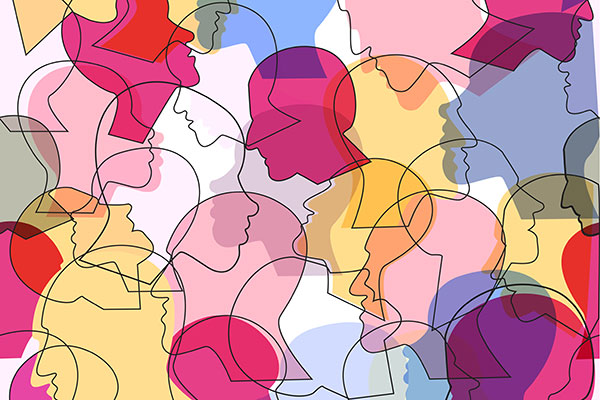As recent calls for technology companies to “share child mental health costs” become louder, this new RSA report argues that we can ensure young people everywhere get timely mental health support they need if central and local government and platform providers work effectively together to increase the coherence of mental health support online for young people.
The mental health of young people and the correlation with exposure to social media are rarely out of the headlines. Indeed, whilst there is a good understanding about the dangers posed to young people online, including cyber-bullying and damaging peer-comparison to carefully-curated digital personas, comparatively little research has been done to assess the quality of information available for young people taking to social media for advice and support about mental health.
As explained further in this previous blog introducing the project, listening to the tone, quality and context of how young people talk about their mental health, though limited as a stand-alone methodology, has been underexplored. We believe that listening exercises, usually isolated to ‘sentiment analysis’ in product development (the process of identifying opinion about a topic or text), can, alongside more traditional research methods, enhance our understanding of the issues facing young people and how they seek help.
This year, the RSA undertook a social media listening exercise to understand better how young people talk about mental health online. The exercise identified 134,000 young people talking about mental health online in the research period and found:
- Mental health is a significant topic of online conversation amongst 19–24-year-olds
- The most common topic of conversation amongst both men and women was depression, but problems with sleep and fatigue were more prevalent amongst young men
- Young people tend to talk about mental health in the evenings during the working week
- Young people tend to share resources among each other (peer-to-peer) rather than engage directly with local service providers
- Local service providers showed limited engagement with young people presenting with mental health problems online, taking a ‘broadcast’ approach as opposed to a dialogue approach
- Forums are still an area where young people discuss mental health issues anonymously. We found impartial advice about treatment and signs and symptoms of mental illnesses hard to come by on these forums and on other platforms.
- Young men dominated online conversations surrounding suicide, where there was some evidence of imagery which ideated self-harm and suicide.
Our research found that not only must we improve the way we engage with young people online to tackle misinformation and poor advice – taking a ‘dialogue’ rather than ‘broadcast’ approach – this must be reinforced with face-to-face support, which kicks in earlier and much more proactively.
Read the report now
Information overload?
The listening exercise uncovered a huge amount of peer-to-peer support and there is much to celebrate in that. However, what is unclear is whether this welcome predisposition to support each other (putting aside the burden that this might place of young people supporting peers) is a symptom of a lack of consistent and easily identified source of support online for young people.
We know that this is a challenge across the UK. A recent Scottish Government backed ‘challenge prize’ has been launched to help young people ‘start the conversation’ about mental health appropriately. The challenge was developed with young people who identified that information online, generally, is “confusing and intimidating if you don’t know what type of issue you have”.
This can have serious consequences. Commenting on a recent cover story in The Times Dr Jon Goldin, vice-chairman of the child and adolescent faculty at the Royal College of Psychiatrists spoke of the “completely unhelpful” groups online that encourage young people to self-harm.
A new service that reflects tech companies’ responsibilities
In our exercise, we could not uncover any “discernible engagement”, which we’ve defined as direct and reciprocal contact with young people, by organisations providing formal support for people talking about self-harm, or most young people discussing mental health online. We suggest that this must end.
Indeed, we warn that a culture of openness amongst young people talking about mental health could lead us to being hostages to fortune as conversations might risk confusing young people or misdirecting them to sources of information and advice that lack credibility.
The report argues for a robust national response to a paucity of engagement with young people discussing mental health online, sometimes for the very first time – and often amongst other young people.
It concludes that public services must make greater efforts to proactively reach young people starting a conversation about mental health online, and recommends that government take action to ensure:
- Public Health England, The Department for Health and Social Care and The Department for Digital, Culture, Media and Sport should work together and establish a working group (including mental health service providers, social media companies and the wider health technologies industry) to investigate how to increase children and young people's access to digitised practical support to manage emotional distress and a mental health condition.
- Engage existing support providers such as Big White Wall, the Samaritans and Childline to assess the efficacy of developing a ‘dialogue’ approach for young people who are raising mental health issues online, involving relevant agencies in the public sector (NHS Trusts, local authorities, schools).
- The Government's Digital Charter should ensure that all digital platform providers meet an accuracy and trust threshold for mental health information and signposting, and require all digital companies to actively report, remove and challenge harmful misinformation
- Pilot a service in selected local authority areas, working across platforms such as Twitter and Facebook to respond to concerns about mental health that young people talk about online. This could pilot techniques such as offering free targeted advertising for a service on their platform.
- NHS England (as part of the formulation of a new 10 Year Plan) should stimulate agencies within STP footprints (CCGs, local authorise and providers) to actively promote dialogic, digital mental health information and interventions to children and young people.
Starting the conversation right
We propose shifting the dial on how public services communicate with young people. A ‘dialogue first’ approach should be trialled to understand how widely held misconceptions, conflation of different illnesses or even imagery that could be seen as romanticising serious issues such self-harm, can be more effectively mediated.
As such, the type of intervention we are advocating for is akin to an NHS ‘111’ service for young people, so that young people can more effectively use existing services as they are equipped with better quality information and advice online. We also argue strongly that this would need to be matched with rapid and tangible improvements to access to treatment for young people. We acknowledge that raising awareness of services that do not have sufficient capacity to respond to need risks committing a double injustice for young people who are already high-risk and underserved.
If we are serious about addressing the mental health crisis among younger people, it is time to make changes across existing services and in the online spaces in which young people spend so much of their time. To do this effectively will require us to really listen to what young people need with respect to their mental health, and for traditional service providers, as well as online platforms, such as Twitter and Facebook to step up and take action.
READ THE REPORT NOW
Related articles
-
Only the people can find a way forward for the NHS
Matthew Taylor
To safeguard its founding principles, it is time to have an informed debate about how to make the NHS sustainable and effective.
-
To confront the housing crisis, do we need to consider more than housing?
Ahmed Shaal
Ahmed Shaal argues we need a more creative debate about housing.
-
Did Bevan's bedpan test set the NHS on the wrong track?
Ed Cox
Ed Cox, Director of Public Services and Communities, argues that the NHS needs a more devolved approach in the decade ahead.




Join the discussion
Comments
Please login to post a comment or reply
Don't have an account? Click here to register.
Tom, do you know about Kooth in Cumbria - https://kooth.com